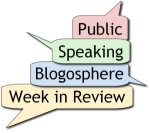
Your speech preparation is going well. You started with your core message, wrapped it in a speech outline, extracted your first draft, edited your speech, and added impact with rhetorical devices. You’re ready to deliver, right?
Wrong. You only have words on paper, and your audience doesn’t want to read your speech.
Your audience wants to see and hear your presentation. You will dazzle them by complementing your speech with staging, gestures, and vocal variety.
This article shows you how.



































